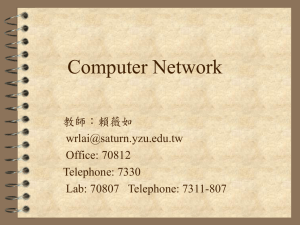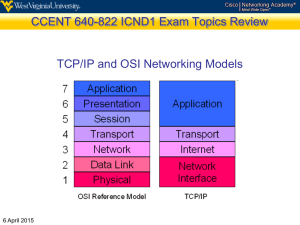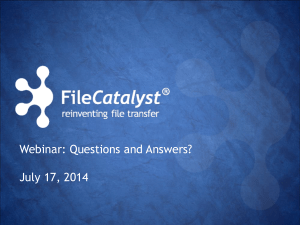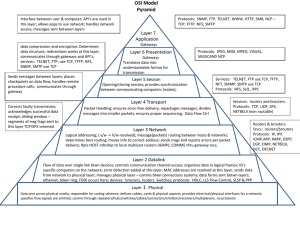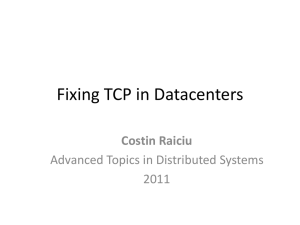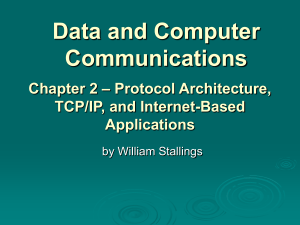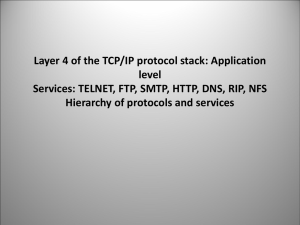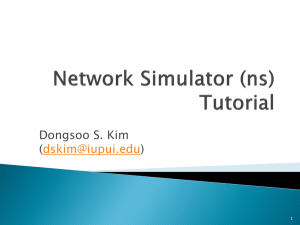Ns-2, the network simulator
advertisement
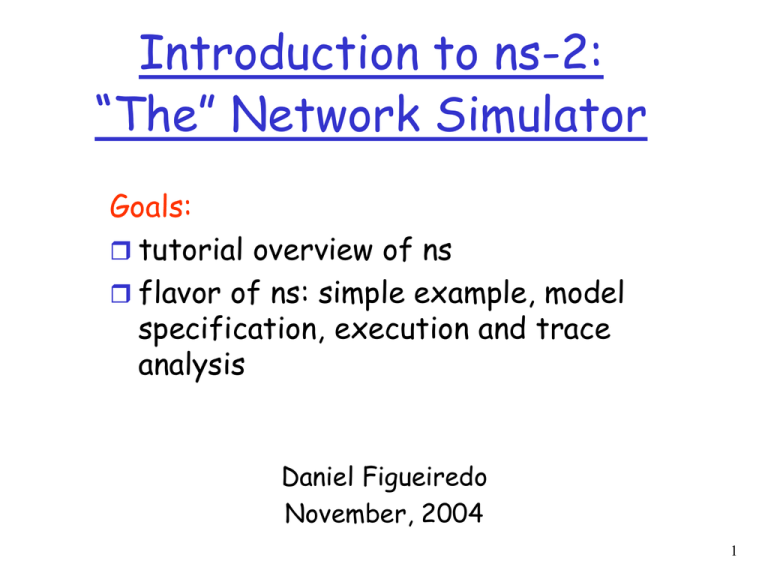
Introduction to ns-2: “The” Network Simulator Goals: tutorial overview of ns flavor of ns: simple example, model specification, execution and trace analysis Daniel Figueiredo November, 2004 1 Ns-2, the network simulator Academic project over 10 years old freely distributed, open source Currently maintained by ISI DARPA + NSF projects ~ 200K LoC, ~400 page manual Large user base mostly academics “de facto” standard in networking research Main website: www.isi.edu/nsnam/ns 2 Ns Functionality Discrete event simulator Traffic models and applications Web, FTP, telnet, audio, sensor nets Transport protocols TCP (Reno, SACK, etc), UDP, multicast Routing and queuing static routing, DV routing, multicast, ad-hoc routing queuing disciplines: drop-tail, RED, FQ Link layer wired, wireless, satellite Infrastructure tracing, visualization, error models, etc modify or create your own modules 3 Ns components Ns, the simulator itself (this is all we’ll have time for) nam, the Network AniMator visualize Ns (or other) output GUI input simple Ns scenarios pre-processing: traffic and topology generators post-processing: simple trace analysis, often in Awk, Perl, or Tcl Tutorial: http://www.isi.edu/nsnam/ns/tutorial Ns by example: http://nile.wpi.edu/NS/ 4 Ns Software Structure: C++ and OTCL Uses two languages C++ for packet-processing per packet processing fast to run, detailed, complete control OTCL for control [our focus] simulation setup, configuration, occasional actions fast to write and change 5 Steps when using Ns Create OTCL script with network model nodes, links, traffic sources, sinks, etc. Parameterize simulation objects queue sizes, link speeds, TCP flavor and parameters (more than 30) Collect statistics dump everything to trace, post process it gather stats during simulation within OTCL script modify Ns source code Run Ns multiple times confidence intervals 6 Creating a Basic Ns Model Create the event scheduler Create nodes and links Create connection Create traffic sources/sinks Enable tracing 7 Creating Event Scheduler Create scheduler set ns [new Simulator] Schedule event $ns at <time> <event> <event>: any legitimate Ns/TCL commands Start scheduler $ns run 8 Creating Network (Nodes + Links) Nodes set n0 [$ns node] set n1 [$ns node] Links: connect together two nodes $ns duplex-link $n0 $n1 <bandwidth> <delay> <queue_type> <delay> determines propagation delay <queue_type> determines queueing policy • DropTail, RED, CBQ, FQ, SFQ, DRR 9 Transport and Traffic Models Two layer approach Transports: TCP, UDP, multicast, etc. transport protocol instances attach to nodes Traffic (applications): (known as agents) Web, ftp, telnet, audio, etc. application instances attach to transport protocol instances generates traffic into transport protocol 10 Creating Transport Channels: TCP source and sink set t_src [new Agent/TCP/Newreno] set t_dst [new Agent/TCPSink] “Newreno” flavor of TCP attach to nodes and each other $ns attach-agent $n0 $t_src $ns attach-agent $n1 $t_dst $ns connect $t_src $t_dst 11 Creating Traffic over TCP Channels FTP create traffic model set ftp [new Application/FTP] default is “infinite” file size attach to TCP channel $ftp attach-agent $t_src schedule start time $ns at <time> “$ftp start” 12 Creating Transport Channels: UDP source and sink set u_src [new Agent/UDP] set u_dst [new Agent/NULL] attach them to nodes, then connect to each other $ns attach-agent $n0 $u_src $ns attach-agent $n1 $u_dst $ns connect $u_src $u_dst 13 Creating Traffic over UDP Channels CBR set cbr [new Application/Traffic/CBR] $cbr set packetSize_ 512 $cbr set interval_ 0.250 $cbr attach-agent $u_src $ns at <time> “$cbr start” 14 Tracing Trace packets on individual links Tracefile format: <event> <time> <from> <to> <pkt> <dst> <seqno> <aseqno> + 1 0 2 tcp 900 ------- 1 0 2 tcp 900 ------r 1.00234 0 2 tcp 900 ------- enqueue dequeue receive drop 1 0.0 3.1 7 15 1 0.0 3.1 7 15 1 0.0 3.1 7 15 packet seq packet flags number ID packet flow nodes involved length ID source dest in this event addresses time + r d <size>--<flowid> <src> packet type 15 Tracing via Monitors Queue monitor queue to access the link Flow monitor particular flow within queue set fmon [$ns makeflowmon Fid] $ns attach-fmon $link $fmon $ns at <time> “puts $fmon set pdrops_” to specify a link, we need: • set link [$ns link $n0 $n1] 16 Walk-through example TCP NewReno W_max = 32 MSS = 1400 TCP SACK W_max = 32 MSS = 1400 2 FTP/TCP sources 1 On-Off (voice) UDP source 1 CBR/UDP 10 FTP/TCP source 0 sources 2 Mbps full duplex 5 msec prop delay 100 packet buffer Drop-tail policy FTP/TCP dest 1 2 acks acks 1 Mbps full duplex 10 msec prop delay 700 packet buffer Drop-tail policy OnOff/UDP CBR/UDP dest 17 Ns Trace file : NS-trace.txt ... + 11.533441 1 2 tcp 1440 ------- 12 1.2 2.4 96 2092 r 11.535694 1 2 tcp 1440 ------- 12 1.2 2.4 65 1527 - 11.537214 1 2 exp 180 ------- 100 0.2 2.13 284 1528 - 11.538654 1 2 cbr 1440 ------- 101 1.11 2.14 155 1530 r 11.547214 1 2 tcp 1440 ------- 12 1.2 2.4 66 1529 + 11.54728 1 2 tcp 1440 ------- 12 1.2 2.4 97 2095 r 11.548654 1 2 exp 180 ------- 100 0.2 2.13 284 1528 + 11.55 1 2 cbr 1440 ------- 101 1.11 2.14 211 2096 - 11.550174 1 2 tcp 1440 ------- 12 1.2 2.4 67 1534 r 11.560174 1 2 cbr 1440 ------- 101 1.11 2.14 155 1530 - 11.561694 1 2 exp 180 ------- 100 0.2 2.13 285 1532 + 11.56222 1 2 tcp 1440 ------- 12 1.2 2.4 98 2097 - 11.563134 1 2 tcp 1440 ------- 12 1.2 2.4 68 1537 r 11.571694 1 2 tcp 1440 ------- 12 1.2 2.4 67 1534 r 11.573134 1 2 exp 180 ------- 100 0.2 2.13 285 1532 - 11.574654 1 2 exp 180 ------- 100 0.2 2.13 286 1536 ... 18 Flow Monitor Trace : packet-trace.txt ... 10 356 1394.6939635123624 1262 906 0 4 7 3 0 10.5 367 1575.3875777393503 1325 958 0 8 15 7 0 1 1 0 0 11 366 1759.8340061666161 1384 1018 0 8 15 7 0 1 1 0 0 11.5 370 1944.0583990191849 1448 1078 0 8 15 7 0 1 1 0 0 12 380 2131.710863713804 1512 1132 0 8 15 7 0 1 1 0 0 12.5 382 2325.178644727122 1558 1176 0 8 15 7 0 1 1 0 0 13 382 2516.7615454470124 1613 1231 0 8 15 7 0 1 1 0 0 13.5 395 2710.8647514290892 1676 1281 0 8 15 7 0 2 3 1 0 14 421 2912.3462186990751 1747 1326 0 16 31 15 0 2 3 1 0 14.5 432 3130.3858423193769 1805 1373 0 16 31 15 0 2 3 1 0 15 436 3344.5896974377333 1862 1426 0 16 31 15 0 2 3 1 0 15.5 462 3571.3811182311597 1937 1475 0 16 31 15 0 2 3 1 0 16 477 3804.653159658757 1995 1518 0 16 31 15 0 2 3 1 0 16.5 495 4049.5929326563519 2057 1562 0 16 31 15 0 2 3 1 0 17 531 4303.9211771379323 2136 1605 0 16 31 15 0 2 3 1 0 ... 19 Results - Queue Statistics Red - instantaneous Green - running average Blue - average w/o transient Light blue - packet drops 20 Results - Flow Statistics Red - TCP flow 1 Green - TCP flow 2 Number of packets in queue mimics TCP Window behavior 21 Performance Queue Statistics Multiple runs to obtain confidence intervals 22
